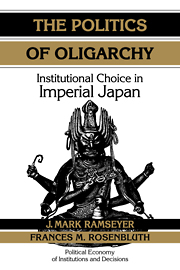Book contents
- Frontmatter
- Contents
- List of tables and figure
- Series editors' preface
- Acknowledgments
- CHAPTER 1 INTRODUCTION
- CHAPTER 2 THE COLLAPSE OF OLIGARCHY: FAILED ATTEMPTS AT CARTEL-MAINTENANCE
- CHAPTER 3 CONCESSION OR FACADE: THE MEIJI CONSTITUTION
- CHAPTER 4 ELECTORAL RULES AND PARTY COMPETITION: THE STRUGGLE FOR POLITICAL SURVIVAL
- CHAPTER 5 THE BUREAUCRACY: WHO RULED WHOM?
- CHAPTER 6 THE COURTS: WHO MONITORED WHOM?
- CHAPTER 7 THE MILITARY: MASTER OF ITS OWN FATE
- CHAPTER 8 FINANCIAL POLITICS
- CHAPTER 9 RAILROAD POLITICS
- CHAPTER 10 COTTON POLITICS
- CHAPTER 11 CONCLUSION: INSTITUTIONS AND POLITICAL CONTROL
- Notes
- References
- Index
CHAPTER 8 - FINANCIAL POLITICS
Published online by Cambridge University Press: 05 June 2012
- Frontmatter
- Contents
- List of tables and figure
- Series editors' preface
- Acknowledgments
- CHAPTER 1 INTRODUCTION
- CHAPTER 2 THE COLLAPSE OF OLIGARCHY: FAILED ATTEMPTS AT CARTEL-MAINTENANCE
- CHAPTER 3 CONCESSION OR FACADE: THE MEIJI CONSTITUTION
- CHAPTER 4 ELECTORAL RULES AND PARTY COMPETITION: THE STRUGGLE FOR POLITICAL SURVIVAL
- CHAPTER 5 THE BUREAUCRACY: WHO RULED WHOM?
- CHAPTER 6 THE COURTS: WHO MONITORED WHOM?
- CHAPTER 7 THE MILITARY: MASTER OF ITS OWN FATE
- CHAPTER 8 FINANCIAL POLITICS
- CHAPTER 9 RAILROAD POLITICS
- CHAPTER 10 COTTON POLITICS
- CHAPTER 11 CONCLUSION: INSTITUTIONS AND POLITICAL CONTROL
- Notes
- References
- Index
Summary
INTRODUCTION
Scholars of pre-war Japan routinely trumpet the bureaucrats' developmental, nation-building prowess. A close examination of pre-war policy, however, reveals a different picture. In Chapters 9 and 10 we examine government policy in the railroad and cotton textile industries. In this chapter, we consider financial policy. We find that at least in the 1920s when the political parties controlled the cabinets, financial policy took on a distinctively partisan quality. Financial regulation was more a weapon in the electoral battle for a legislative majority than a means to achieve any economic supremacy.
That the two main parties had distinct constituencies, as we discussed in Chapter 4, shaped their financial policy choices. The Kenseikai and Minseito favored big banks and international firms, whereas the Seiyukai cultivated ties to farmers, small firms and small banks, and domestically oriented manufacturers. This chapter recounts the financial policy shifts that accompanied changes in cabinet control.
Section 2 provides a broad historical sketch of pre-war financial regulation, noting that the Meiji oligarchs never achieved bank consolidation. Section 3 focuses on the Banking Act of 1927. Once in control of the cabinet, the Kenseikai drafted banking regulations that favored the largest banks, undermining the Seiyūkai's support base among the small banks.
In banking regulation, as with any area of policy governed by statute, control of the cabinet alone was not enough. However loyal and clever the bureaucrats, an obstreperous Diet could thwart legislative plans.
- Type
- Chapter
- Information
- The Politics of OligarchyInstitutional Choice in Imperial Japan, pp. 103 - 117Publisher: Cambridge University PressPrint publication year: 1995
- 1
- Cited by



